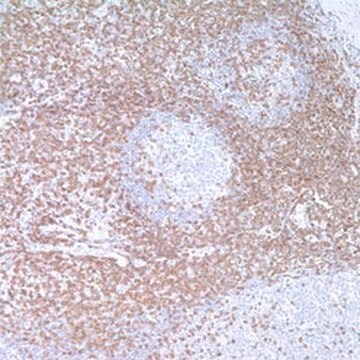Based on the information available, this version does recognize the epsilon subunit. This conclusion is drawn from the fact that the CD3 epsilon, also known as the cytoplasmic CD3 antibody, exhibits a cytoplasmic staining pattern with perinuclear Golgi accentuation and very rarely membranous. Typically, this antibody is utilized for identifying T cell and NK cell lymphomas in FFPE tissues (please refer to representative staining photos). While the Cd3 surface antibody is commonly used in flow cytometry for membranous CD3 detection, the CD3 epsilon cytoplasmic is generally used in FFPE tissue, as is often done for IHC.
103R-9
CD3 (MRQ-39) Rabbit Monoclonal Antibody
About This Item
Productos recomendados
origen biológico
rabbit
Nivel de calidad
100
500
conjugado
unconjugated
forma del anticuerpo
culture supernatant
tipo de anticuerpo
primary antibodies
clon
MRQ-39, monoclonal
descripción
For In Vitro Diagnostic Use in Select Regions (See Chart)
Formulario
buffered aqueous solution
reactividad de especies
human
envase
pkg of 0.1 mL concentrate (103r-94)
pkg of 0.5 mL concentrate (103R-95)
pkg of 1.0 mL concentrate (103R-96)
pkg of 1.0 mL predilute (103R-97)
pkg of 7.0 mL predilute (103R-98)
fabricante / nombre comercial
Cell Marque®
DIV
for in vitro diagnostic use
técnicas
immunohistochemistry (formalin-fixed, paraffin-embedded sections): 1:100-1:500 (concentrated)
isotipo
IgG1
control
tonsil
Condiciones de envío
wet ice
temp. de almacenamiento
2-8°C
visualización
membranous
Información sobre el gen
human ... CD3E(916)
Categorías relacionadas
Descripción general
Calidad
 IVD |  IVD |  IVD |  RUO |
Ligadura / enlace
Forma física
Nota de preparación
Otras notas
Información legal
¿No encuentra el producto adecuado?
Pruebe nuestro Herramienta de selección de productos.
Elija entre una de las versiones más recientes:
Certificados de análisis (COA)
¿No ve la versión correcta?
Si necesita una versión concreta, puede buscar un certificado específico por el número de lote.
¿Ya tiene este producto?
Encuentre la documentación para los productos que ha comprado recientemente en la Biblioteca de documentos.
-
Could you confirm if the CD3 clone (Catalog #103R-96) recognizes epsilon?
1 answer-
Helpful?
-
Active Filters
Nuestro equipo de científicos tiene experiencia en todas las áreas de investigación: Ciencias de la vida, Ciencia de los materiales, Síntesis química, Cromatografía, Analítica y muchas otras.
Póngase en contacto con el Servicio técnico
